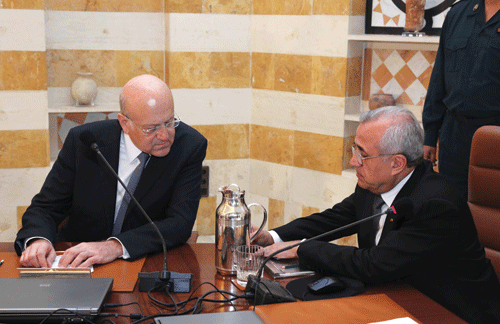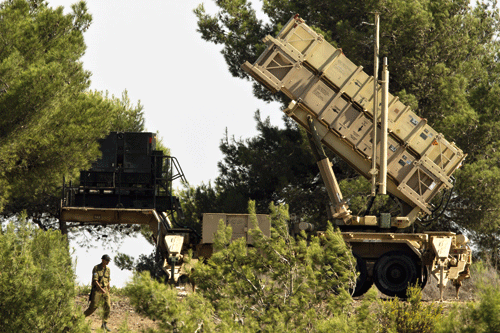Today’s smartphones increasingly resemble “mini laptops”, allowing users on-the-go access to the Internet. They are about to get more useful and addictive, becoming wallets as well, allowing users to pay with their mobile phones. Google Wallet, launched in 2011, is an example of a system allowing users to tap their phones for payments. It is still early days and the adoption of phone payments is still nascent. In the Middle East, cash transactions remain the primary means of payment but Basel el-Tell, Levant regional manager of MasterCard Worldwide, is calling for the region to increase its adoption of electronic payments. While in Beirut, he sat with Executive to discuss the technological changes in electronic payments and their implementation in the Middle East and Lebanon.
Have you witnessed a change in consumer patterns during the Arab revolutions?
While there is a tendency to save, there has not been a shift in spending habits and overall spending is still growing across the region. Point-of-sale transactions are up 32 percent in the first half of 2012 relative to the same period last year. Some countries have been affected by a reduction in tourism but overall spending in the region is still steady.
One year on from MasterCard and Visa’s ban on all Syrian issued cards, how have you been affected by this ban and how many cards were impacted?
We don’t issue figures on cards in Syria but everything was halted: debit cards, credit cards etc. The United States placed sanctions on Syria and we don’t see [our ban] changing unless there is a change in regime.
What percentage of Middle East consumers holds a credit or debit card?
In the region, electronic payment methods account for less than 10 percent of total payments as cash and checks still account for more than 90 percent of payments. In Europe and in North America, electronic payments reach 20 percent; cash and checks still dominate. This is one of our drivers: we want to see a world beyond cash. Our competition is cash and checks. Cash is very expensive as it costs between 1 and 1.5 percent on average of a country’s gross domestic product to print cash, transport it and secure it. We are working with governments to replace cash and checks with electronic payments.
For instance, in Egypt we are working with the Ministry of Finance on a program enabling the payment of employees’ wages by payroll cards. In the United Arab Emirates, we are working with the Ministry of Labor on a wage protection system whereby all migrant workers are paid electronically. This will allow the government to make sure that people are paid on time. In Lebanon, we are working on several projects with local partners. We have made inroads but we don’t have anything to declare today. We see momentum and we think we will shortly see projects where government payments start taking place electronically.
With the ‘Gauss’ virus attacking Lebanese banks recently, what is MasterCard doing to help alleviate consumer concerns regarding electronic payments?
We are aware of this issue and we are working with our technology and security teams to monitor the situation as it evolves, to prevent any impact to our business and our cardholders. We recommend that consumers continue to be diligent when it comes to protecting their personal financial information when they are online. It’s important to take steps such as making sure your virus protection software is current and features the latest updates. Also, consumers should refrain from clicking on links in emails that come from unknown sources for their own protection.
Near field communication (NFC) is gaining more and more traction among mobile phone developers recently, and it was a disappointment for Apple fans when the new iPhone 5 did not offer this technology. Tell me a bit about it and why it is so important.
Imagine you are walking around in New York City and you want to eat a pizza. You go on Google maps and it shows you the closest pizza place. You can then book a table, order your pizza online and you can pay while you walk to the pizza place. It saves time and it is very secure. In 15 to 20 years, plastic will disappear in most of the world. Currently, many issuers are using NFC technology and we are working on it in the region too.
With the region still behind in adopting plastic but with mobile penetration on the rise, can we go straight to mobile payment and jump plastic?
Mobile penetration in the region shows this is the way forward but we need the infrastructure to make sure the mobile partners are ready. Some telecommunications operators in the region are not able to execute such technology. In Qatar, we launched a Qatar Telecommunication and Qatar National Bank solution so Qataris can walk into a Pizza Hut and pay with their phones. At the beginning, people will be hesitant but the learning curve will take place. We know that the Lebanese culture is one of entrepreneurship, innovation and early adoption of technology. We think PayPass (MasterCard’s “Tap and Go” cards) will be a hit.
How does PayPass work and how successful has it been in the region?
PayPass cards are made up of a radio chip that resides in the card and when it ‘sees’ a contactless reader, it starts communicating. It is designed for low value payments and does not require a signature or a PIN. If the value exceeds the limit put forth by the bank, you need to input the PIN. In the future, you will just tap your phone and not the card. It has been adopted in 41 countries in the world and four in the region: the UAE, Qatar, Egypt and Lebanon.
How many banks in Lebanon offer this technology?
Two banks in Lebanon offer PayPass: Fransabank launched it in 2006 and Bank Audi [launched September 30]. It has been mostly used by Fransabank’s international travelers and some local clients.
How many readers are available in Lebanon for this technology?
There are around 300 PayPass readers in Lebanon currently but we will see many more in the future. There is currently an aggressive marketing plan with retailers and ABC Group, one of the biggest retailers with seven outlets and two big malls, is deploying readers. Bank Audi, which is deploying the readers for ABC, will be installing 2,000 readers in the next 12 months and another 3,000 readers after that.
When do you think Lebanon will be “tapping and going”?
Some banks are still offering magnetic strips and some are moving to chip now. Remember ‘zip-zap’ payments? It used to be zip-zap then magnetic then chip then contactless (such as PayPass) and then NFC. There is a learning curve. Less than 10 percent of the current available readers are Bluetooth GPRS enabled machines, the ones that move to you, and that is because they cost three times more than the regular readers (a Bluetooth reader costs $500 to $1200 vs. $150 to $300 for a regular reader). The acquirer — the MasterCard or Visa licensed financial institution — pays for the reader and often charges the retailer a fee for using it, with an average 2 percent of sales on machine paid to the acquirer.
What does the future of electronic payments look like?
Everything will be on your phone in the end. Your life is on it. It is becoming a big part of our lives.











